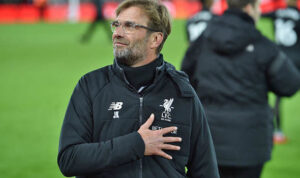Mohamed Salah vs. Leeds United: Player Performance Review
Sometimes impossible to handle, always tireless, determined, often peerless, absolutely special; Mohamed Salah demonstrated plenty of what it is that makes him special in Liverpool’s Premier League opening fixture against Leeds United.
As usual, this review will look at some key aspects of the player’s game, and, in the case of Mohamed Salah, we will be looking at one of the world’s very best football players. Should be fun.
In terms of the raw numbers, the impact he had on his team, and the level of success which followed, few can boast of a better time in the Premier League than Liverpool forward Mohamed Salah.
Sometimes impossible to handle, always tireless, determined, often peerless, absolutely special; Mohamed Salah demonstrated plenty of what it is that makes him special in Liverpool’s Premier League opening fixture against Leeds United.
As usual, this review will look at some key aspects of the player’s game, and, in the case of Mohamed Salah, we will be looking at one of the world’s very best football players. Should be fun.
Moving The Ball
There is sometimes confusion over what a ‘dribble’ actually is in football; you might call the act of moving while in control of the ball ‘dribbling’, and you would be right.
A dribble in a statistical sense is a take-on attempt. A player must attempt to beat or go past a defender while in possession of the ball. Dribbling with the ball is named a ‘carry’ and moving with the ball towards the opponent’s goal is called a ‘progressive carry’.
Against Leeds, Mohamed Salah topped the charts in each of these areas, and by quite a distance. We’ll focus on the dribbling.
There are three main aspects to focus on with the running and dribbling of Mohamed Salah from this game, and each of them, in different ways, point towards the same place – getting the player closer to the goal.
The first is a style that ex-Liverpool forward Luis Suarez is a master of.
Salah makes the early darting run wide of his marker, and he expects the through pass to be played ahead of him and at enough pace to beat the defender. The ball from Henderson is too direct, almost too accurate, and hits Salah as he runs. Clumsy, but he is still in possession. The dribble comes next.
Rather than attempting to knock the ball past the defender, Salah plays through him. Suarez would do the same. The timing of the touch is important, as is the balance to knock the ball through the defender’s legs on the second contact. He turns, waits, and plays into the defender, coming out (almost) cleanly on the other side. It looks rough, it’s not pretty, but it’s very effective.
The second example is the one we probably see most often from Mohamed Salah.
For this dribble, Salah drops deep of his marker and peels into a wide area. He faces the pass, shows the pass to his feet, and controls close to his body. He has one intention: to attack the defender.
Opening his body with the first control, Salah gives himself likely avenues both outside of the defender and inside, there is no obvious or even likelier route to commit to defending.
After a series of short, closely controlled touches, Salah shows the outside, cuts inside, turns with a neat drag-back and beats his man finally on the outside. It’s a textbook close control take-on. Dictate to your defender, don’t allow the defender to show you where to go.
The final example of a dribble is the most aesthetically pleasing. Not only does it look lovely, but it is also deadly effective forward play.
Salah has dropped into the midfield on this occasion, and while that is perhaps not an area you would typically associate with such a great runner, he does this more often than you may imagine. We’ll get to that a bit more later.
He comes from wide right to a slightly more central position to receive a ball to feet with his back to goal, it is Joe Gomez tasked with finding him accurately and with enough pace on the pass to facilitate that ‘touch around the corner’. He reversed direction, flicking the ball to his left, and with a swivel of the hips, he is beyond the marker and in position to play the cutting pass.
It is certainly planned and rehearsed, almost like a set-piece, and it is a very effective way of beating and breaching the midfield very quickly.
Three styles, three ways to beat a man. Whether you take a wide run and trust your legs to win the race, bamboozle with a flip-flap or flapjack or whichever en vogue skill move you’re capable of, swivel the hips and send him the wrong way, or simply run through him, a dribble is always about beating your man and moving into a more advanced, more optimum area. Salah usually beats his man.
There is More to Goals than Scoring
He scores a lot of goals, Mohamed Salah.
For his time at Liverpool, Mohamed Salah has scored 76 goals in 109 Premier League appearances.
0.70 goals per game would make Salah the most prolific goalscorer in the competition’s history.
— The Tactical Times (@Tactical_Times) September 12, 2020
But what is sometimes forgotten is Mohamed’s ability as a creative force in that forward line. He isn’t a striker, Jurgen Klopp’s Liverpool don’t bother with strikers. He is a winger, an inside forward, an attacking mid, a centre forward; he is many, many things. Among them, Mo Salah is a contributor.
Among the different passing criteria used to measure creative effectiveness is the ‘pass into opposition penalty area’. Self-explanatory. A pass, short or long, made from outside of the opponent’s box to a teammate inside the opponent’s box. It’s a good way of assessing how incisive or penetrative a player’s passing tends to be over a large sample of games.
Mohamed Salah plays approximately four of these passes per game on average in the Premier League. Against Leeds, he played five.
For these aspects, positioning – both starting position and the positions the player moves into when in possession – are just as important as the pass itself.
Here’s a great initial example.
Salah takes a winger’s starting position. He is on the flank, outside of the full-back. You can see the stark contrast to Sadio Mané on the opposite side, who is moving between defenders in the left half-space.
This kind of asymmetrical movement is typical of Liverpool’s two world-class wide forwards. Mané comes in to receive the ball and play for Firmino, Salah drops wide to offer the advanced option ahead of play.
It is Naby Keita who plays the ball to feet, and Salah is primed to attempt another dribble – similar to one we covered -, he leads his defender on the outside, as we would expect, then inside, but instead of cutting back outside with a heavy touch and sprint, Salah maintains short control and checks inside into 2-3 yards of space created for himself by himself.
Meanwhile, Naby Keita is continuing his run as the extra man, always difficult to track, and accelerates ahead of his defender into the vacant space.
Salah has created the angle, Keita has provided the option, and Salah is now able to split the defenders with a relatively simple through pass into the box. Simple, but very effective.
The movement and decisions made by every player involved in the move, not just Keita and Salah, as well as the execution of the passes, create the opportunity.
The next example looks more at the fluidity and interchanging of roles and positions between Salah and Mané.
The attacking phase begins, as they so often do, with a Liverpool centre back.
With van Dijk in possession, you can immediately see both Mané and Salah are on the same side of the pitch; Salah on the flank, deeper, again like a winger; and Mané moving through the right half-space in a more advanced area ahead of Salah. Mané would be closer to a centre forward in this scenario.
By the time Keita has intercepted the clearance, Wijnaldum has played the short pass on the edge of the area, and between him and Firmino possession is lost again, Salah is now outside of the D in the right half-space, and Mané has advanced into the box towards the penalty spot. Two excellent, optimum attacking areas.
Henderson intercepts this time, and Salah is still in yards of space. Mané is waiting on the last man, primed to make the run. It is a typical exchange between a playmaker 10, found in space in zone 14, and the advanced 9, ready to move into a 1 on 1 high-quality goal scoring situation.
With a right foot first touch, and a smooth left foot perfectly timed through ball, Salah plays the pass and Mané moves into the box free of his markers.
Another simple enough move in principle, but also another excellent example of how the starting positions and the positional decisions enable the opportunity. Before a forward can create or score a chance, they must first be in a position to do so. Again, simple in principle.
The final example is all about assurance and assertion.
Jordan Henderson wins possession with a powerhouse of a tackle and immediately moves into an advanced area. While there are options across the front line, there is one clear and obvious passing lane and attacking option.
Mohamed Salah opts not to run beyond his marker and play for the cutting through pass by Henderson, he instead drops off the defender to offer a clearer option. Salah wants to contribute to the phases, he isn’t forcing the play in order to be at the end of the attack.
From this position, he has options. It is another really smart, really promising attacking area. He has Trent Alexander-Arnold running wide, he has Mané advancing between defenders towards the far-post, and he has Firmino in space in the central area. Salah takes no time to consider his options and instead plays the optimum, simple short pass to Firmino, the man closest to him.
A combination of the pass being a little too central and Firmino making a mess of his first touch means the chance is lost, but, from the position Salah receives the ball, there is so much attacking potential. Of all the choices available, he took the most sensible, most likely path.
We cannot say the same for the follow-up back heel Salah tries when recovering the ball, but it is another example of Salah acting on instinct. One great instinctive decision followed by one poor instinctive decision.
Shooting: the Bread and Butter
If there is one aspect of Mo Salah that has people talking, the reason he is world-famous, the reason he is valued at over £100,000,000, it’s the goals. 96 of them in total for Liverpool (so far).
If this review does one thing, I hope it explains why Salah is so much more than a great scorer of goals, but at the same time, we can’t deny that clear, obvious, and excellent aspect of his game. He scored three against Leeds.
The penalties he scored were tremendous in their own way: for the technique that Salah employs when hitting his penalties. It is unique and very effective
Salah’s penalties are excellent. He calms himself, take a long, deliberate, emphatic run-up, and this is where they can differ. The run-up he takes suggests he is going to put a lot of power behind his penalty, and on this occasion he does. He smashes it centrally.
There is very little chance of a goalkeeper saving this. He would not only need to stand up to the penalty, something we don’t see very often, but also need to stop a high ball hit very hard, coming at him very fast.
The second penalty shows another side of this.
This penalty was taken to win the game. The score is level at 3-3 in the 85th minute, Salah again steadies his breathing, he again approaches the ball from a distance at pace with plenty of determination, again it looks a lot like he is going to smash the ball, but this time he places a controlled side-footed finish to the bottom corner, sending the goalkeeper the wrong way.
There is chaos in his approach, aggression, and a lot of belief. A penalty being saved can have as much to do with the striker as it does the goalkeeper.
When you apply that kind of confidence to your actions, and assert yourself to that degree, I feel it is unlikely you will fail. Salah very rarely fails with his penalties. He has scored 11 of 12 for Liverpool.
His other goal was something quite different entirely.
There are two main offensive groups for this set-piece; the bigger runners – Henderson, Firmino and van Dijk; and the loiterers – Wijnaldum and Salah. The first group attack the ball, the second drop back, wait and play for the second ball.
When the ball is cleared, Salah is again in prime position. There is an element of luck in any second ball recovered so close to goal, but there is also an element of intelligent positioning. Salah is covering an area of the box that the ball is likely to fall into if the headed clearance isn’t firm, controlled or generally simple. With van Dijk attacking, and Robertson playing the kind of balls he is capable of, there was always a good chance that clearing this ball would not be a simple task.
The clearance isn’t a bad one, but it is glanced, and that enables Salah to take the touch in his stride with the right boot, swivel the body, and strike with his left. What a strike it is.
As with the pass to Firmino, and as with the penalties, Mohamed Salah strikes this ball with absolute certainty. The technique is excellent, as we would expect from such an accomplished scorer of goals, but more than the technique is the belief he hits this shot with. The shot is true; the definition of a sweet connection.
He had no doubts over what he intended, and he executed it without thought nor concern.
Another example of this kind of belief in his ability to strike the ball:
The move begins with another piece of excellent Salah build-up play, so that’s worth taking in, but the chance isn’t until Robertson delivers the early cross.
Mané is the first runner, Firmino backing him up, Salah has made no attempt to enter the box and is instead holding back, again looking for that second ball. Again he finds the second ball.
He approaches the looping clearance with confidence, he strikes it first-time on the volley with belief; it sails over the crossbar. He had very little control over this shot, and a more delicate approach would have been better, but that isn’t always possible with a player like Salah.
He decides what to do and he attempts it. It doesn’t always work, it isn’t always the best option, but he acts with belief in his actions.
Mohamed Salah Superstar
When we talk about ‘the best’, we often deviate towards forwards – usually great goal scorers or scorers of great goals. It’s a natural bias that has occurred throughout football discussion for decades.
It’s often advised to separate players by position – it is, after all, very difficult to directly compare a centre forward, a defensive midfielder, and a goalkeeper, for example – and in doing so, you realise that Liverpool currently have one (or more) of the world’s best in a number of different areas.
The reason these players are the best isn’t necessarily through renown or years of sustained dominance, but through the almost superhuman output and exertions many of those players have demonstrated over the past 2-3 years for Liverpool at the highest level.
Jurgen Klopp takes a good player and makes him great. He has done this throughout his career. If this idea can be embodied at Liverpool, I think the player Mohamed Salah became at the club is the perfect example.
Salah always possessed the raw materials to be an excellent forward – pace, strength, exuberance, control and skill – but he lacked perhaps the confidence or self-belief to be the best. He found that at Liverpool.
More than a goalscorer, more than a creator, more than a winger, more than a forward. A player difficult to typify, a player who cannot be limited or contained – both figuratively and literally; I find that the best players are like that. Mohamed Salah is certainly among the best.


